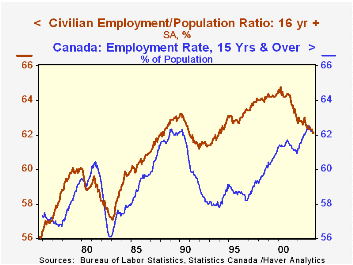 Global| Sep 05 2003
Global| Sep 05 2003Canadian Employment Down, Unemployment Up in August
Summary
Canadian labor market conditions softened again in August, extending Julys deterioration. Employment fell slightly, by 19,000, and the unemployment rate rose 0.2% to 8.0%, its highest since December 2001. In July, the employment [...]

Canadian labor market conditions softened again in August, extending July’s deterioration. Employment fell slightly, by 19,000, and the unemployment rate rose 0.2% to 8.0%, its highest since December 2001. In July, the employment decline, which totaled 13,300, was concentrated among youth aged 15-24. While that age-group saw a further decrease in August – 2,600 – the bulk of the fall was seen by adults, which went down 16,500, erasing a gain in July.
Among industries, the job loss was largest in "management, administrative and other support" (-23,800) and in "health care and social assistance" (-17,600). In contrast, jobs increased in public administration (13,500), construction (10,600), and accommodation and food services (8,500).
Last month in this space, we noted that employment in Canada has been stronger recently than in the US. While the US has had a so-called "jobless recovery" since November 2001, employment in Canada merely flattened during that US recession and climbed to a new peak in subsequent months, reaching an all-time high in June. The divergent behavior of US and Canada employment conditions is seen in the accompanying chart, which shows the employment ratios for each country. The data coverage is slightly different, with the Canadian labor force defined as those aged 15 and over, while US data begin at age 16. This detail hardly alters the story, though, in which Canadian jobs recovered vigorously during the mid- to late-1990s and again after the US recession, while the US has seen flat employment (by the labor force definition) during the post-November 2001 recovery, accompanied by a noticeable decrease in the employment/population ratio.
[As in the US, Canadian statistics officials explained prominently that the power outage in mid-August, afflicting Ontario, hurt hours worked severely, but did not affect the number of workers employed. Indeed, total hours worked fell 3.1% in August, the largest month-on-month decline in the 27-year history of the labor force data.]
| August 2003 |
July 2003 |
June 2003 |
Year/ Year |
2002 | 2001 | 2000 | |
|---|---|---|---|---|---|---|---|
| Change in Total Employment (thousands) |
-19.0 | -13.3 | +48.8 | +48.8 | Dec/Dec % Change | ||
| 3.7% | 0.1% | 2.2% | |||||
| Unemployment Rate (%) | 8.0% | 7.8% | 7.7% | 7.5% (Aug.2002) |
Annual Average | ||
| 7.6% | 7.2% | 6.8% | |||||
Carol Stone, CBE
AuthorMore in Author Profile »Carol Stone, CBE came to Haver Analytics in 2003 following more than 35 years as a financial market economist at major Wall Street financial institutions, most especially Merrill Lynch and Nomura Securities. She had broad experience in analysis and forecasting of flow-of-funds accounts, the federal budget and Federal Reserve operations. At Nomura Securities, among other duties, she developed various indicator forecasting tools and edited a daily global publication produced in London and New York for readers in Tokyo. At Haver Analytics, Carol was a member of the Research Department, aiding database managers with research and documentation efforts, as well as posting commentary on select economic reports. In addition, she conducted Ways-of-the-World, a blog on economic issues for an Episcopal-Church-affiliated website, The Geranium Farm. During her career, Carol served as an officer of the Money Marketeers and the Downtown Economists Club. She had a PhD from NYU's Stern School of Business. She lived in Brooklyn, New York, and had a weekend home on Long Island.





